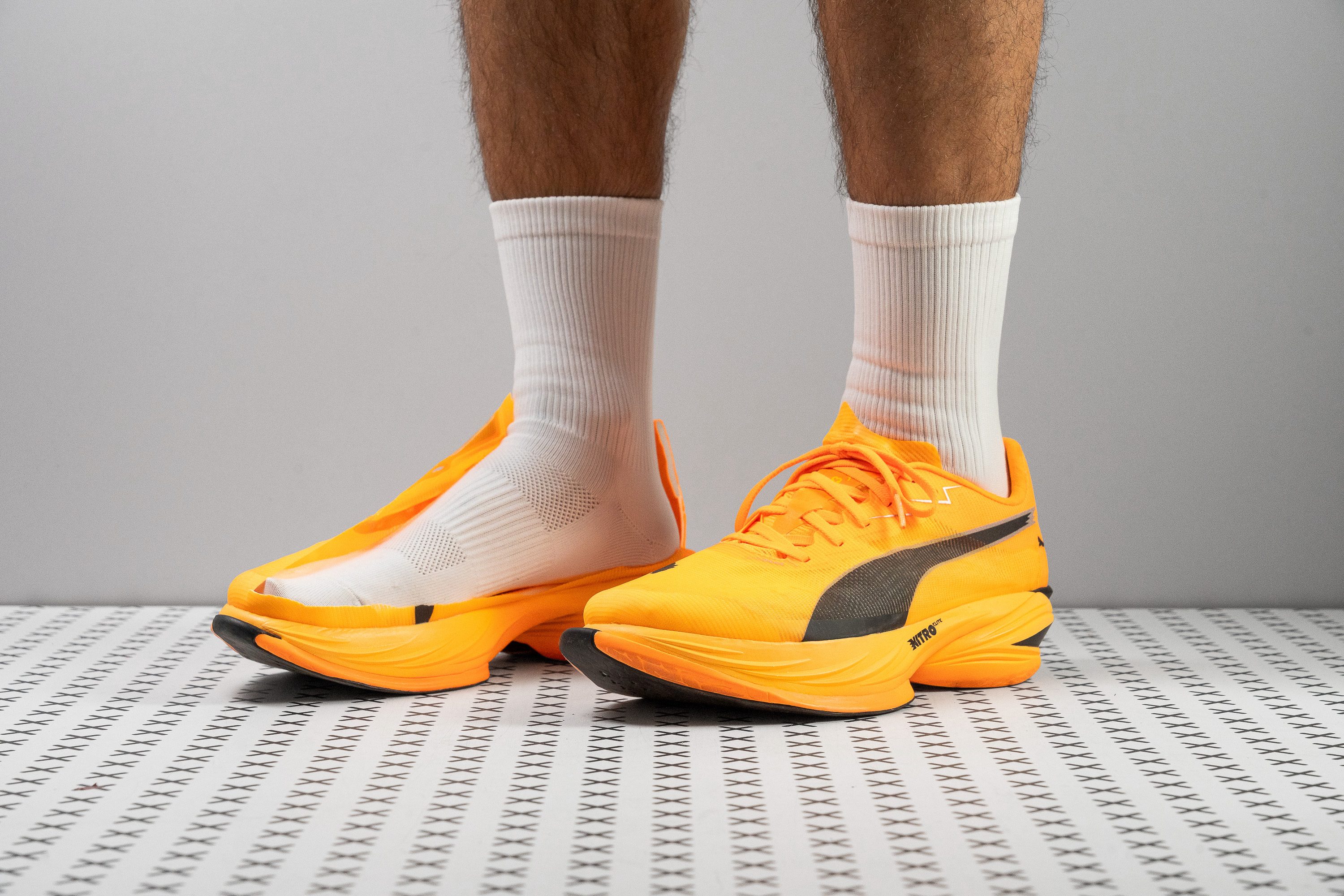Our verdict
- Top pick in best PUMA running shoes
- Top pick in best super shoes
Pros
- Insanely fast and incredibly fun
- Exceptional energy return from A-TPU foam
- Premium Ultraweave upper
- Innovative extended plate design
- Perfect for 5K/10K
- Excellent shock absorption for long distances
- Includes two different lace types
- Reliable lockdown
- Huge weight reduction compared to version 2
Cons
- Higher price than before
- Extremely unstable
- Very limited durability
- Unsuitable for heel strikers
Audience verdict
- Top 25% most popular running shoes
Comparison
The most similar running shoes compared
+ + Add a shoe | |||||
|---|---|---|---|---|---|
| Audience score | 85 Good! | 90 Superb! | 90 Superb! | 90 Superb! | |
| Price | $300 | $230 | $500 | $250 | |
| Pace | Competition | CompetitionTempo | Competition | Competition | |
| Shock absorption | High | High | High | High | |
| Energy return | High | High | High | High | |
| Traction | High | High | High | High | |
| Arch support | Neutral | Neutral | Neutral | Neutral | |
| Weight lab Weight brand | 6.1 oz / 173g 6 oz / 170g | 7.2 oz / 204g 7.4 oz / 209g | 4.9 oz / 139g 4.9 oz / 138g | 6.5 oz / 183g 6.4 oz / 181g | |
| Lightweight | ✓ | ✓ | ✗ | ✓ | |
| Drop lab Drop brand | 8.3 mm 8.0 mm | 10.6 mm 8.0 mm | 7.8 mm 3.0 mm | 6.5 mm 5.0 mm | |
| Strike pattern | HeelMid/forefoot | Heel | - | Mid/forefoot | |
| Size | - | True to size | - | Slightly small | |
| Midsole softness | Balanced | Soft | Balanced | Balanced | |
| Difference in midsole softness in cold | Small | Normal | Small | Small | |
| Toebox durability | Bad | Bad | Bad | Good | |
| Heel padding durability | Decent | Good | Good | Good | |
| Outsole durability | Bad | Decent | Bad | Good | |
| Breathability | Moderate | Moderate | Breathable | Breathable | |
| Width / fit | Narrow | Medium | Narrow | Narrow | |
| Toebox width | Medium | Narrow | Narrow | Medium | |
| Stiffness | Stiff | Stiff | Stiff | Stiff | |
| Torsional rigidity | Stiff | Stiff | Stiff | Stiff | |
| Heel counter stiffness | Flexible | Flexible | Flexible | Flexible | |
| Plate | Carbon plate | Carbon plate | Carbon plate | Carbon plate | |
| Rocker | ✓ | ✓ | ✓ | ✓ | |
| Heel lab Heel brand | 38.5 mm 40.0 mm | 39.2 mm 40.0 mm | 38.4 mm 39.0 mm | 39.1 mm 39.5 mm | |
| Forefoot lab Forefoot brand | 30.2 mm 32.0 mm | 28.6 mm 32.0 mm | 30.6 mm 36.0 mm | 32.6 mm 34.5 mm | |
| Widths available | Normal | Normal | Normal | NormalWide | |
| Orthotic friendly | ✗ | ✓ | ✗ | ✓ | |
| Season | All seasons | All seasons | - | SummerAll seasons | |
| Removable insole | ✗ | ✓ | ✗ | ✓ | |
| Ranking | #202 Bottom 45% | #38 Top 11% | #52 Top 15% | #73 Top 20% | |
| Popularity | #89 Top 25% | #50 Top 14% | #73 Top 20% | #99 Top 27% |
Who should buy
Through our testing, we found that the PUMA Fast-R Nitro Elite 3 is designed for:
- Runners chasing one of the fastest racing shoes ever created... or perhaps the fastest!
- Midfoot and forefoot strikers with a neutral gait who want a competition shoe proven by lab data to enhance performance.
- Those who appreciated the concept of the previous edition but found it too heavy. Version 3 underwent a highly-successful liposuction.
- PUMA fans looking for the brand’s ultimate supershoe, no matter the price.
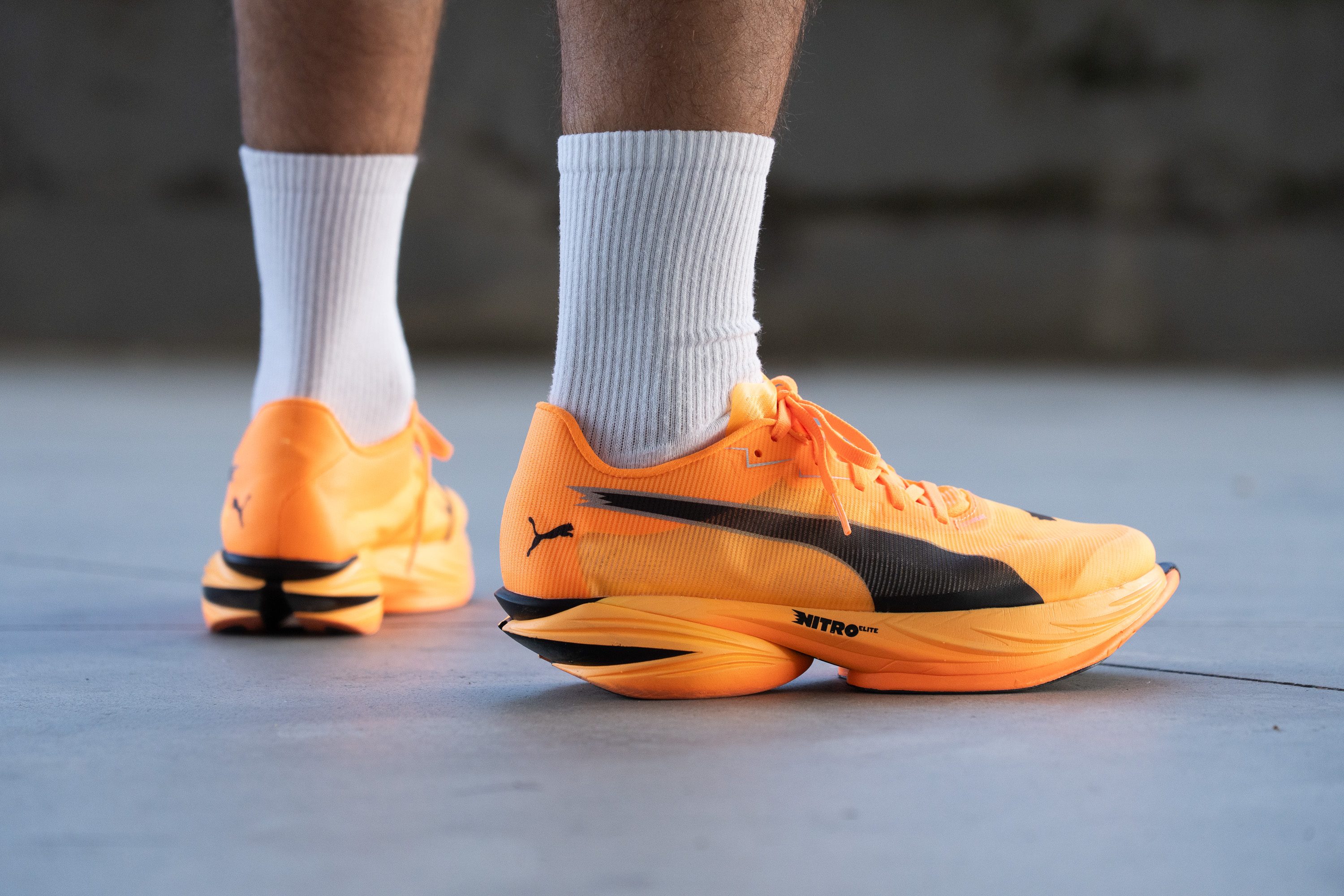
Who should NOT buy
We think the PUMA Fast-R Nitro Elite 3 isn’t the best choice for most runners, as its wild ride and poor stability can make it difficult to control, and that's a problem especially over marathon distances. For a more stable yet still lightning-fast option, we believe shoes like the Nike Alphafly 3 or Adidas Adizero Adios Pro 4 are much safer bets.
We also found the durability of the Fast-R Nitro Elite 3 disappointingly low. The ultra-thin upper and minimal outsole rubber wear down quickly, making it a poor investment for runners who like to extend a supershoe’s life into training sessions. Based on our lab data, we think models like the Saucony Endorphin Elite 2 or ASICS Metaspeed Sky Paris offer much better long-term value.
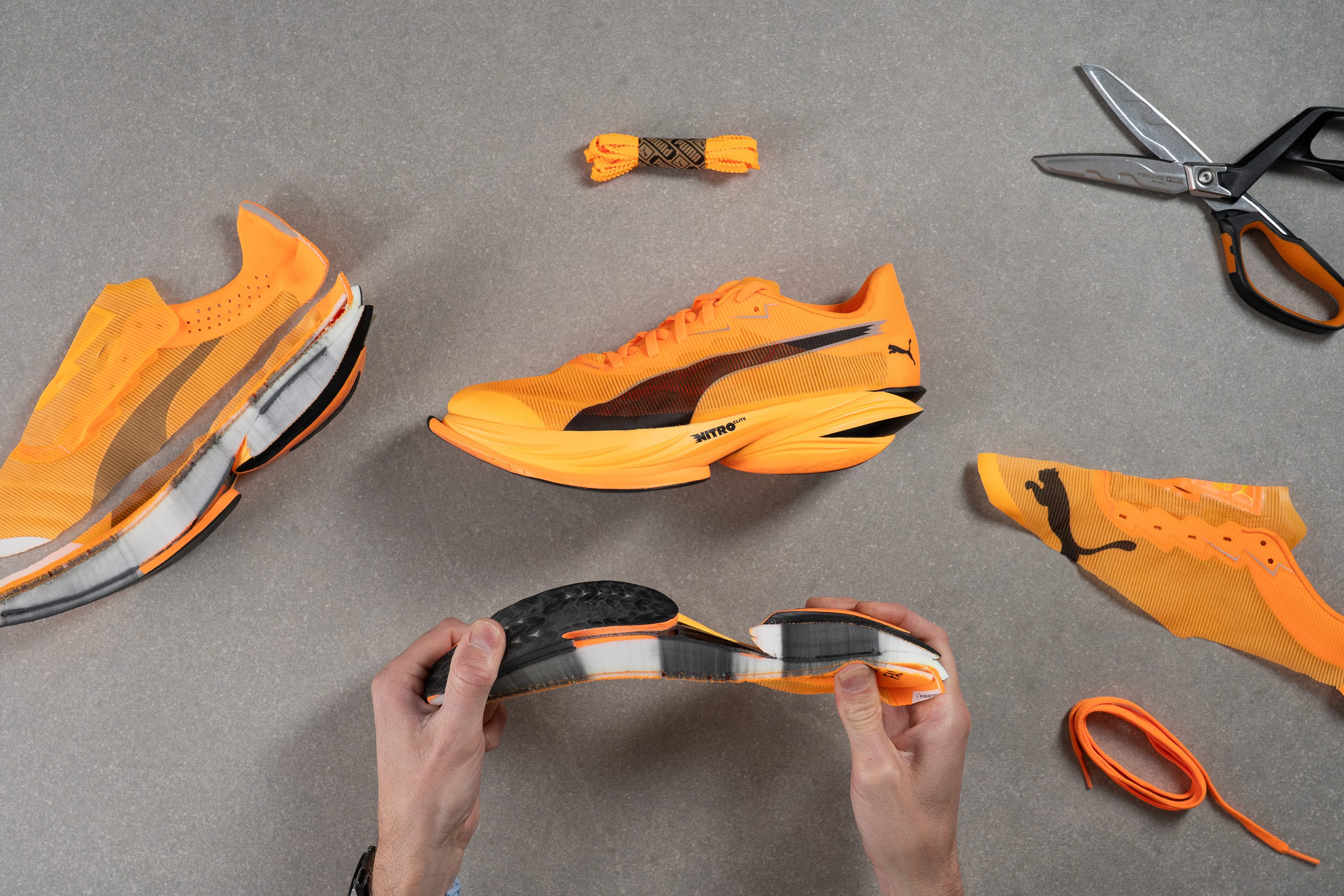
Cushioning
Shock absorption
PUMA wanted to ensure that the Fast-R Nitro Elite 3 was truly ready to handle any race distance, and they absolutely succeeded. While in anything shorter than a half marathon, high shock absorption is not that important on race day—recovery is a different story—when tackling a marathon, it becomes crucial to have enough cushioning for the muscles and joints.
With 148 SA in the heel and 124 SA in the forefoot, we discovered that the Nitro Elite 3 offers enough protection to keep the legs as fresh as possible for the last 10K of a marathon, or even for those grueling long runs if you are crazy enough to use it for training.
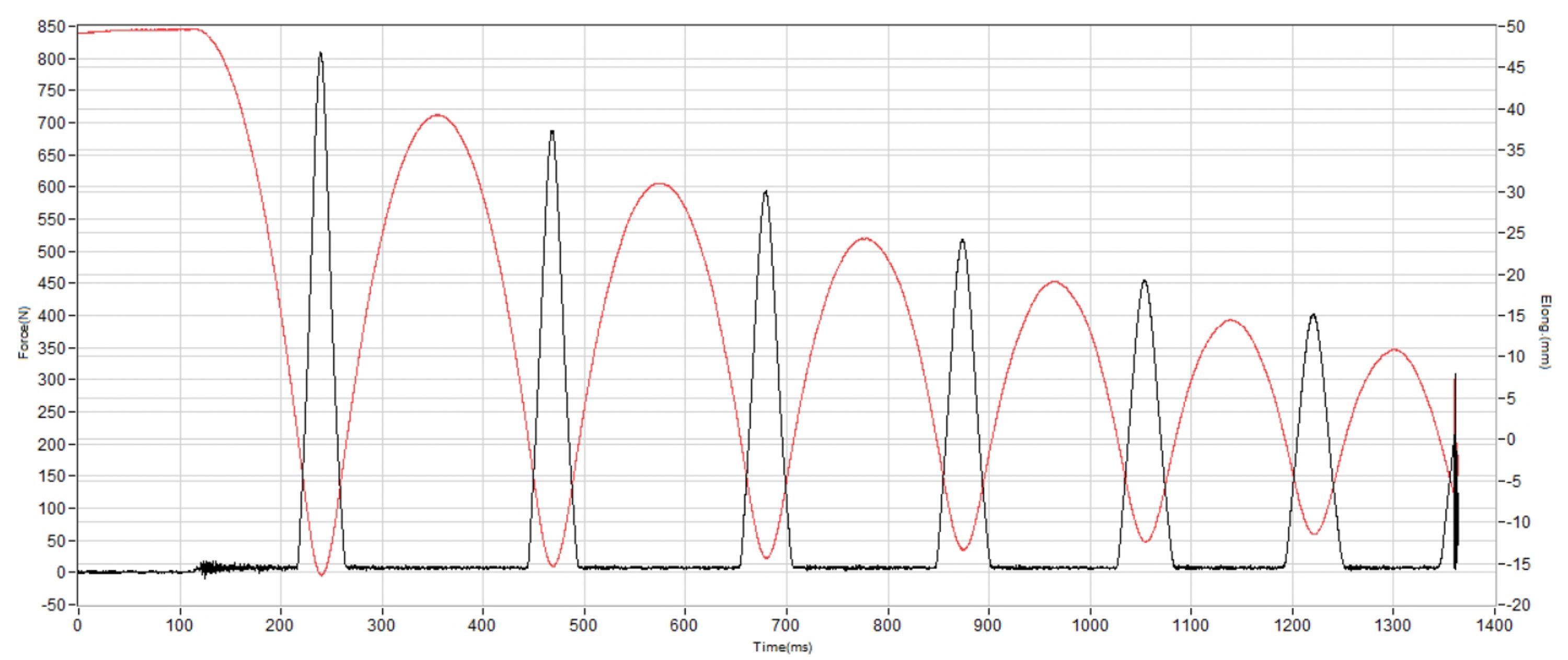
| Fast-R Nitro Elite 3 | 148 SA |
| Average | 129 SA |
Energy return
If your goal is to shave time off your personal best, the PUMA Fast-R Nitro Elite 3 deserves a spot on your radar. It’s the only shoe to demonstrate measurable and significant gains in running economy since Nike’s groundbreaking 2017 Vaporfly study, and PUMA went all in by hiring the same leading scientist for their study: Wouter Hoogkamer, from the University of Massachusetts.
According to the University of Massachusetts study, the Fast-R Nitro Elite 3 improved running economy by up to 3.6% across a broad range of runners—and impressively, every single participant showed an improvement.
Part of this comes from the shoe’s ultra-light build and its weird-looking extended carbon plate design. But we can't forget the new Nitro Elite foam, made from A-TPU, which achieved an outstanding energy return of 80.4% in the heel and an exceptional 82.6% in the forefoot. This is as good as it gets, at least for now.
| Fast-R Nitro Elite 3 | 80.4% |
| Average | 58.5% |
Heel stack
PUMA really pushed the limits with this shoe, and we measured 38.5 mm of stack height in the heel, just shy of the 40 mm cap set by World Athletics. However, when we moved the calipers toward the midfoot, the shoe clearly exceeded that limit, using a clever geometry trick similar to what Mizuno took to the extreme with the Wave Rebellion Pro 2.
This marathon-ready stack feels impressively high and offers massive cushioning, though we still think it’s not the best option for heel strikers due to its aggressive shape.
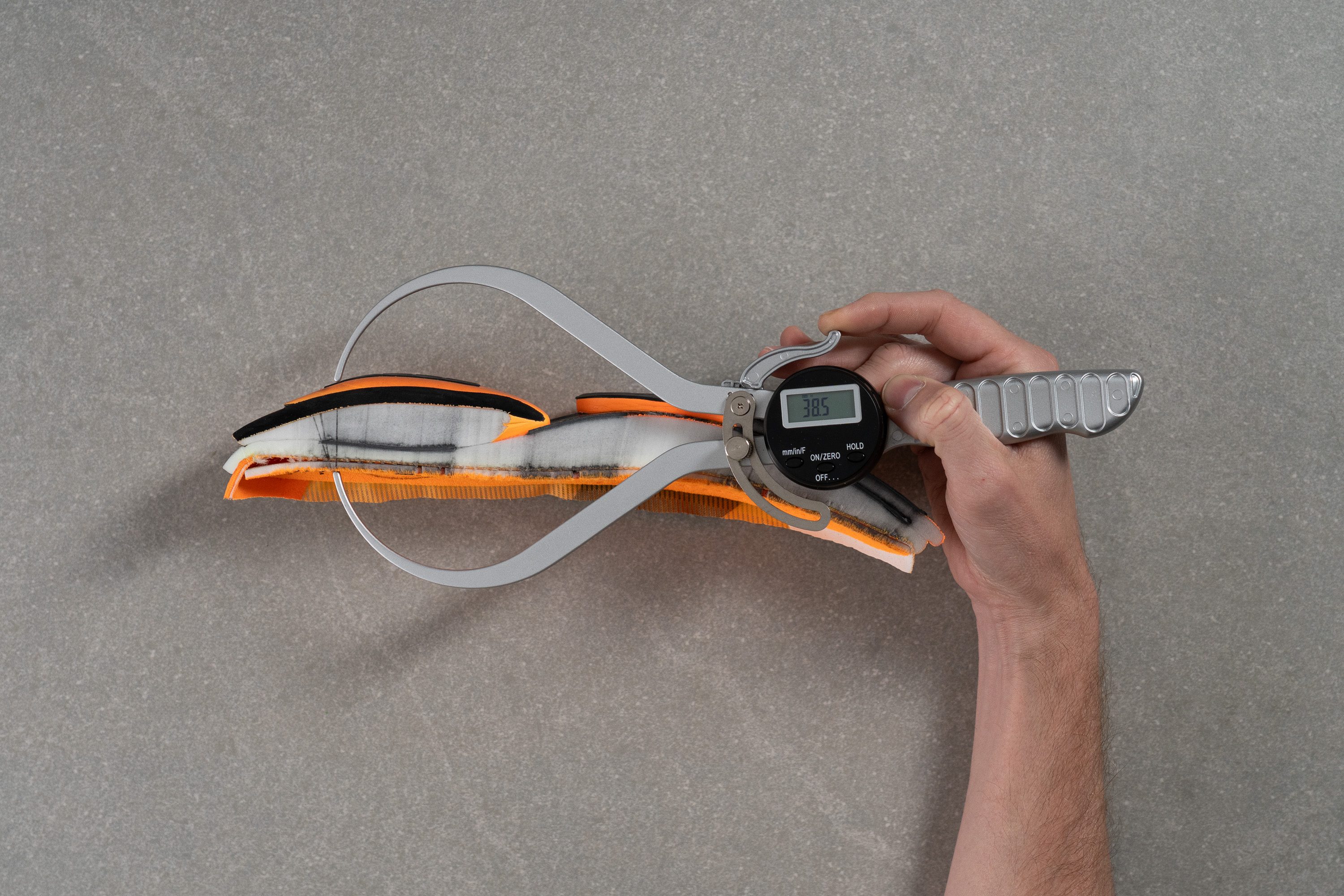
| Fast-R Nitro Elite 3 | 38.5 mm |
| Average | 34.7 mm |
Forefoot stack
The forefoot packs a generous 30.2 mm of foam, giving the Fast-R Nitro Elite 3 an advantage over supershoes like the Brooks Hyperion Elite 5, which provide less front cushioning and can feel lacking for longer distances.
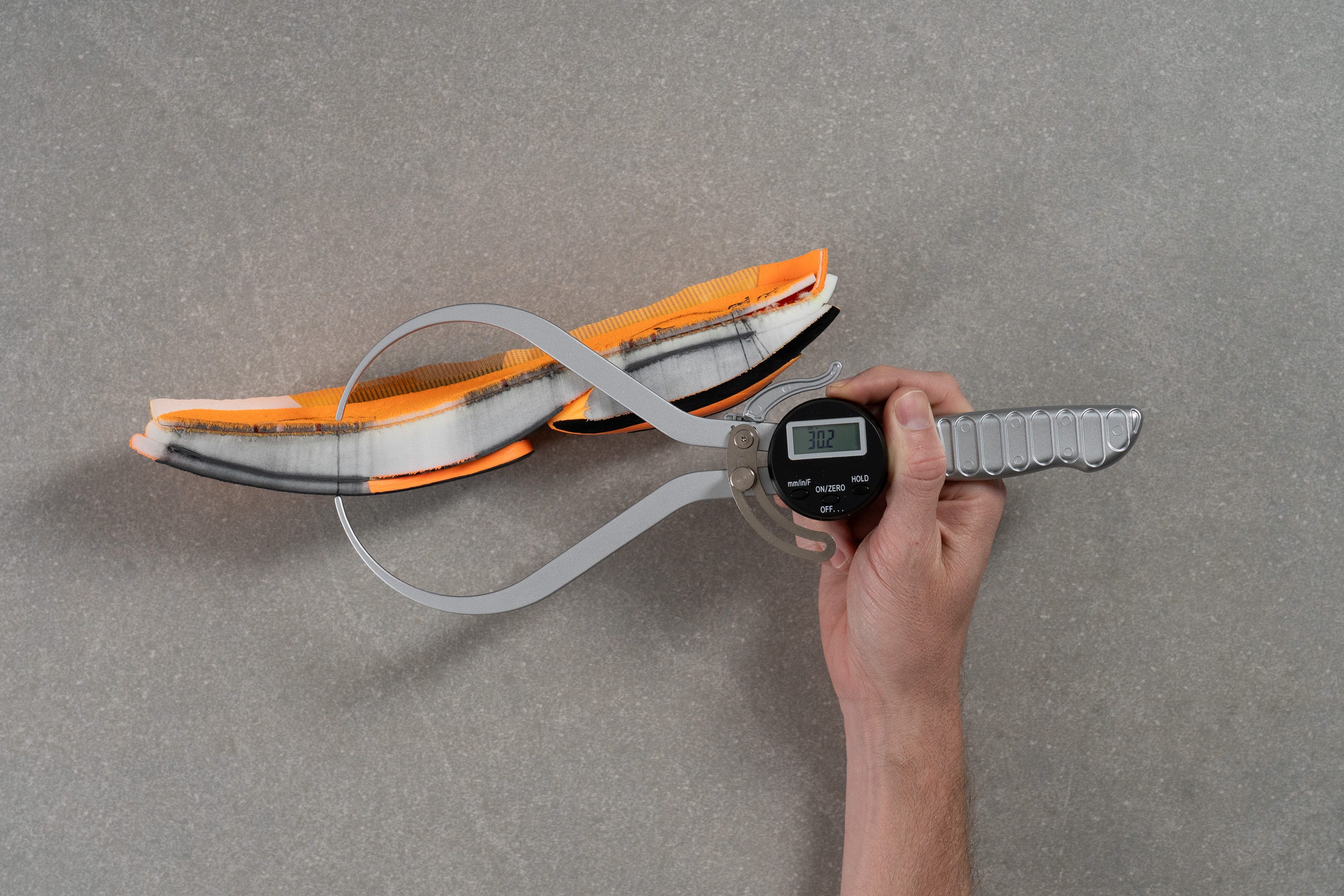
| Fast-R Nitro Elite 3 | 30.2 mm |
| Average | 26.1 mm |
Drop
It’s great to see that PUMA’s stated numbers align so closely with our findings. They list an 8 mm heel-to-toe drop, and we measured 8.3 mm, which is virtually identical.
With this drop, the Nitro Elite 3 delivers a ride that suits all footstrikes. It avoids risky geometry experiments, opting instead for a trusted setup that feels smooth for both short and long distance racing.

| Fast-R Nitro Elite 3 | 8.3 mm |
| Average | 8.6 mm |
Midsole softness
What truly sets the Fast-R Nitro Elite 3 apart from its competitors is its much more direct ride. You know, some still fall into the trap of assuming that a firmer feel means less energy return, but that couldn’t be further from the truth. That’s why providing real lab data, not just subjective impressions, is so essential when analyzing a running shoe.
Our tests proved that this aliphatic TPU is exceptionally responsive, and our softness measurements confirm that it’s far from being a plush foam. Scoring 20.1 HA, it sits right in the middle. Rather than feeling soft, it delivers a ride that's similar to how the suspension of a high-performance supercar feels on the road, and it's an ideal supershoe for those who dislike plush foams for racing.

| Fast-R Nitro Elite 3 | 20.1 HA |
| Average | 20.4 HA |
Secondary foam softness
This shoe features the familiar dual-layer superfoam setup with a carbon plate sandwiched in between. The secondary layer uses essentially the same foam, measuring 19.8 HA—almost identical to our initial reading.
Why isn’t it exactly the same score? Supercritical foams contain tiny air bubbles, which cause small variations in durometer readings. That’s why we take four measurements and use the average rather than relying on just one.
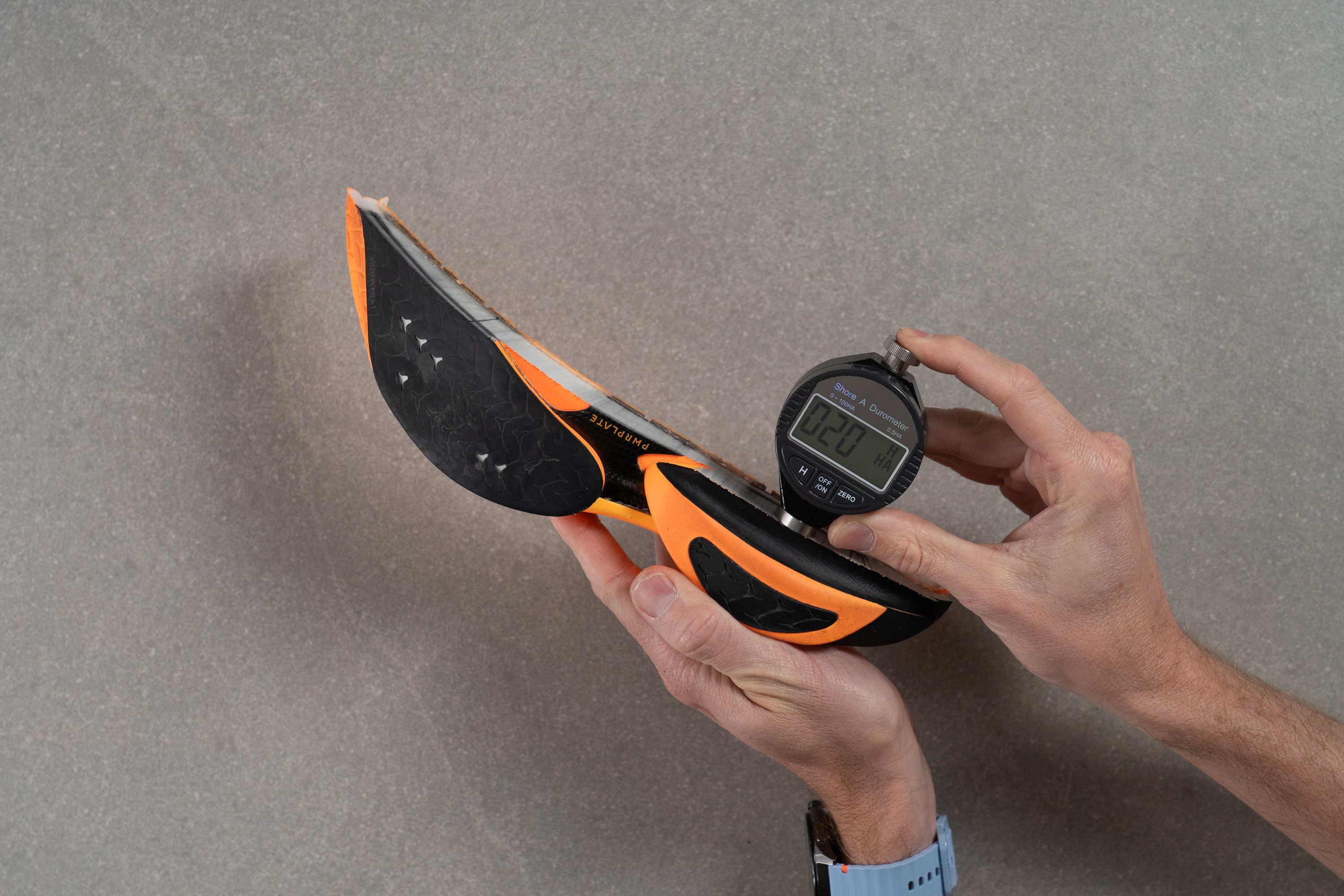
| Fast-R Nitro Elite 3 | 19.8 HA |
| Average | 22.6 HA |
Rocker
Looking at our rocker “mug photo,” it’s clear that the Fast-R Nitro Elite 3 showcases a truly distinctive geometry. We found an aggressive heel shape with an ultra-late landing zone that discourages heavy heel striking, combined with the protruding plate design and a late-start rocker design.
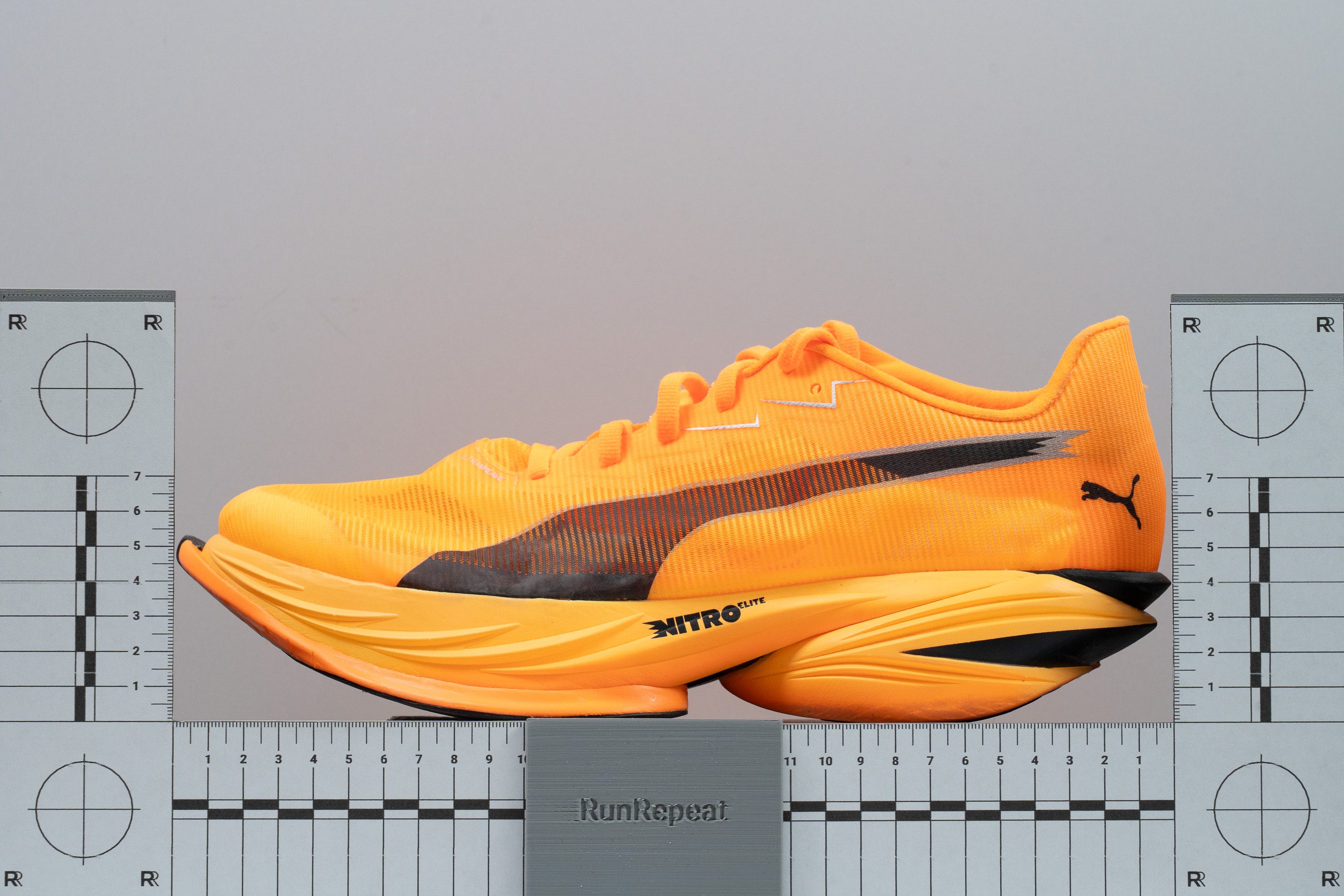
Plate
One of the standout innovations that PUMA currently keeps exclusive is its extended design of the so-called PWRPLATE. It's simply unlike anything seen before in road racing shoes, and PUMA highlights it as a core contributor to the Fast-R Nitro Elite 3 performance edge against other supershoes.
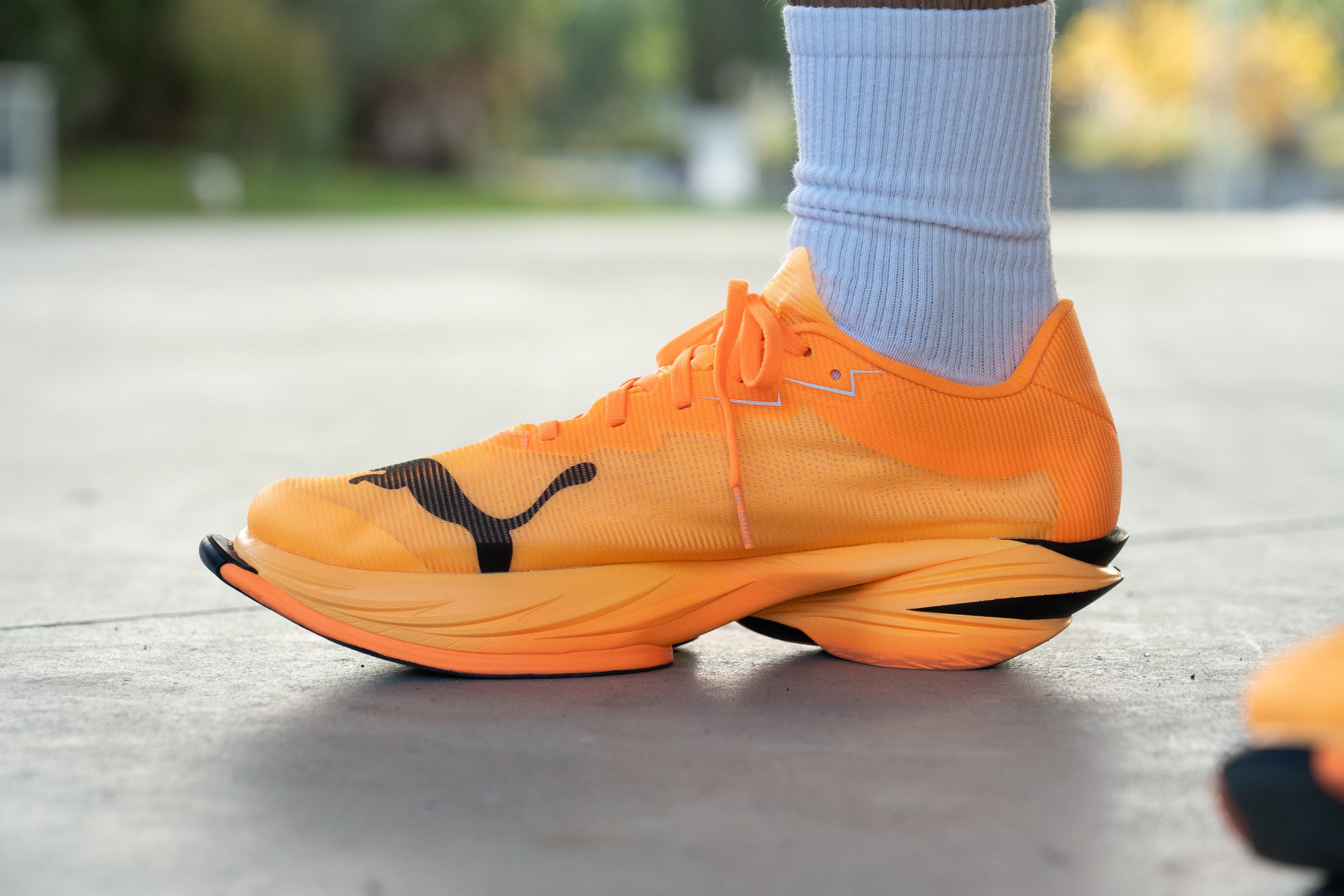
Viewed from the side, the plate resembles the typical spoon shape found in most supershoes, with its leverage point positioned beneath the ball of the foot. However, it also plays a central role in the shoe’s decoupled midsole system, remaining fully exposed through the midfoot.
But does it actually work? PUMA stands firmly behind this bold plate concept, and their lab data backs it up. We’ve also spotted prototypes from other brands experimenting with similar extended plate setups, so...
Size and fit
Size
Width / Fit
The Fast-R Nitro Elite 3 isn’t designed for wide feet, yet it’s far from an ultra-narrow running shoe. During our first on-foot test, we discovered a snug fit ideal for short races and manageable for many marathon runners, though some may prefer going half a size up.
To compare it accurately with other models, we created a gel mold of the interior and conducted precise measurements. The widest point reached 92.9 mm, making it slightly tighter than most shoes.

| Fast-R Nitro Elite 3 | 92.9 mm |
| Average | 95.1 mm |
Toebox width
The toebox is slightly narrower than average, though only by a small margin, measuring 72.3 mm in our lab test.
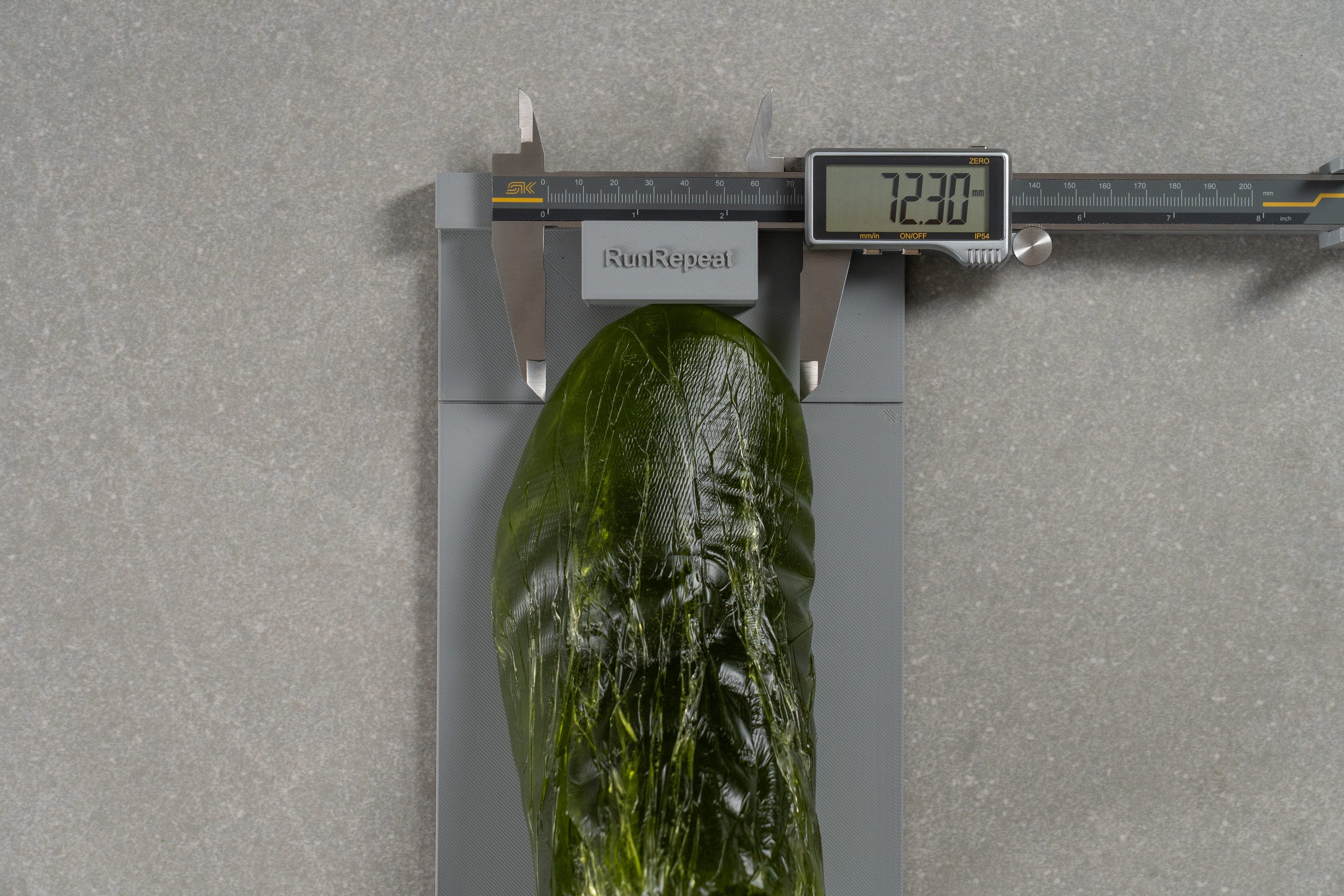
| Fast-R Nitro Elite 3 | 72.3 mm |
| Average | 73.3 mm |
Toebox height
Good news for runners who dislike uppers that constantly press on their toes, as the Fast-R Nitro Elite 3 avoids that issue entirely.
It's not roomy at all, but offers just the right amount of space while maintaining a secure, race-ready fit.
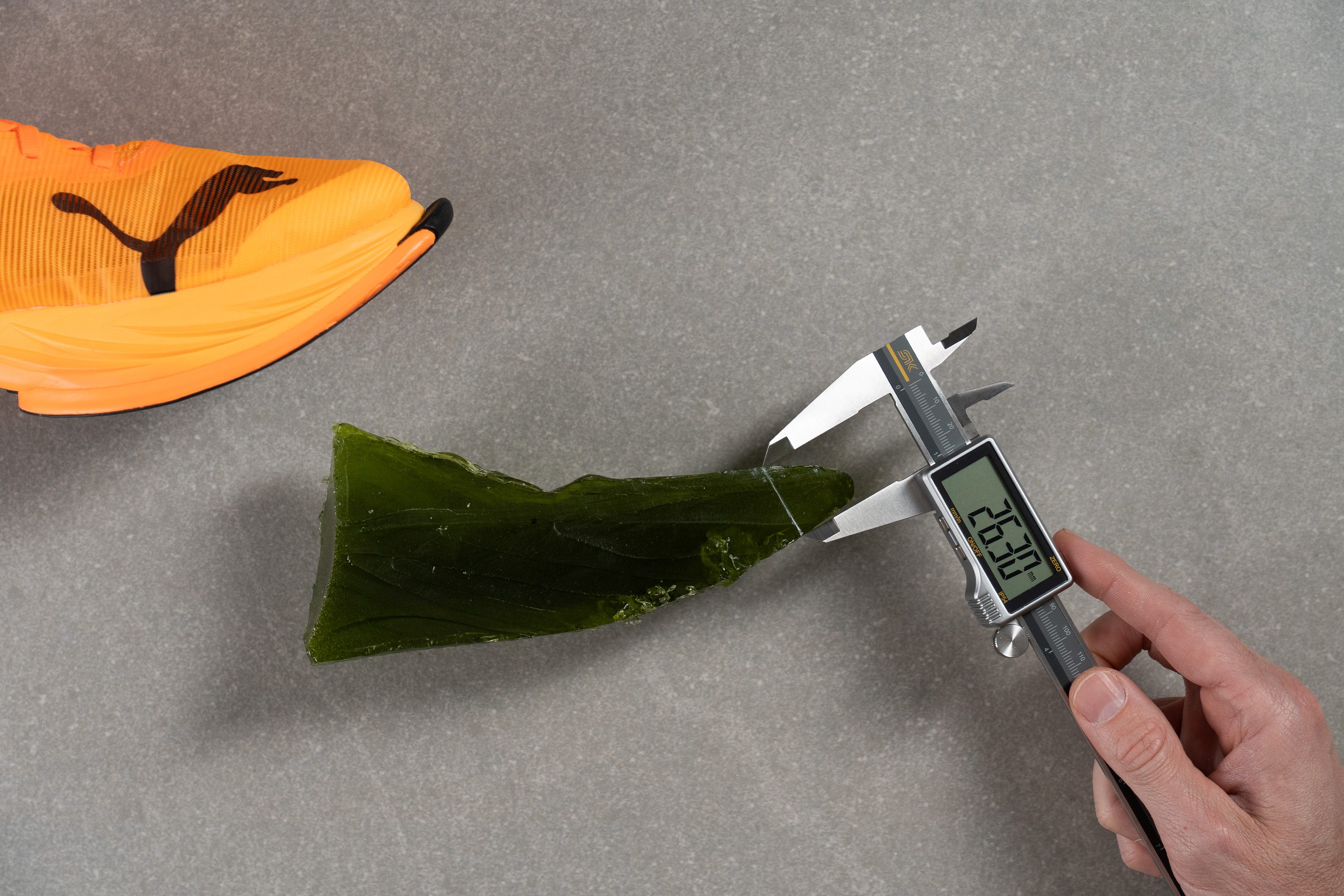
| Fast-R Nitro Elite 3 | 26.3 mm |
| Average | 27.0 mm |
Traction / Grip
Traction test
PUMA has made an almost hard-to-believe evolution over the past five years with its running shoes, and one of its standout advantages over most brands is the extra-grippy PumaGrip rubber. It performs beautifully in training models like the excellent Velocity Nitro 4 and shows the same race-ready traction in supershoes like the Fast-R Nitro Elite 3.
We tested it on a slab of wet concrete and recorded a 0.71 score—an ultra-strong result that proves its high-performance traction and dependable control in virtually any racing condition.
| Fast-R Nitro Elite 3 | 0.71 |
| Average | 0.48 |
Outsole design
The outsole of the Fast-R Nitro Elite 3 features a fully decoupled design, splitting the heel and forefoot with a large central void that exposes the PWRPLATE. This layout reduces weight but offers little stability for heel strikers, as there’s minimal rear cushioning and surface contact.
Up front, the full rubber coverage with PumaGrip provides superb traction. The geometry looks definitely odd but serves a purpose: maximizing efficiency and responsiveness for fast runners.

Flexibility / Stiffness
We discovered that the Nitro Elite 3 delivers an intense ride that won’t suit every runner, and one of the main reasons is its extremely high stiffness. In our 30-degree flex test, it registered an impressive 23.1N.
This is another reason we consider this shoe a pure race-day weapon, and it’s not a versatile supershoe that can easily double for everyday runs.

| Fast-R Nitro Elite 3 | 23.1N |
| Average | 15.3N |
Weight
One of the standout improvements in the Fast-R Nitro Elite 3 compared to its predecessor is the remarkable weight reduction it achieved.
We tested this version at just 6.1 oz or 173g, while the Fast-R Nitro Elite 2 hit 9.3 oz or 264g. Although the previous model was clearly too heavy for a modern supershoe, this lightweight, transformation is still impressive.

| Fast-R Nitro Elite 3 | 6.1 oz (173g) |
| Average | 9.3 oz (264g) |
Breathability
One of the areas where PUMA managed to shed the most weight is the upper. The so-called Ultraweave fabric is extremely thin, and we were eager to test its real-world breathability and comfort.
We discovered that ventilation is solid, allowing the shoe to handle hot-weather runs with ease. It might fall slightly short of maximum airflow, but a 4/5 score is still fantastic.
Then we moved the upper over a bright LED ligh source, and we identified the internal structure. PUMA clearly went for an ultra-minimal approach, reinforcing only key areas such as the heel and the lacing system to keep everything featherlight.

Next, we placed the shoe under our microscope to examine the Ultraweave fabric up close.
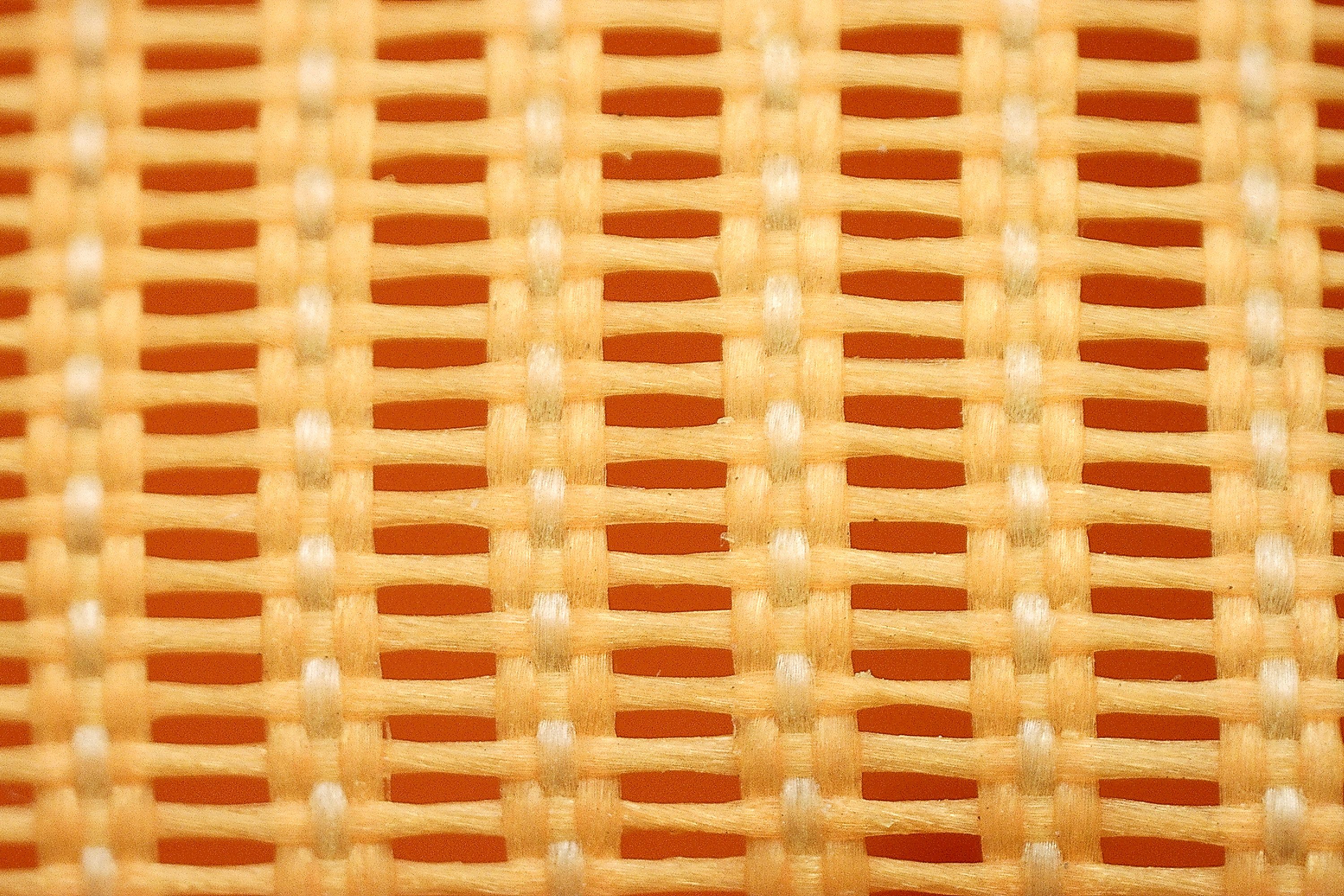
The material proved to be premium-grade, confirming that the shoe’s high price tag is backed by excellent materials from top to bottom.
We also appreciated the generous heel padding, which delivers real comfort. PUMA made a clever design choice here by opting for a classic heel collar design, and the inclusion of small ventilation holes in the collar adds a touch for improved airflow in that area.
| Fast-R Nitro Elite 3 | 4 |
| Average | 3.7 |
Stability
Lateral stability test
This is one of the most unstable supershoes on the market, making it a poor match for anyone who strays even slightly from a neutral gait. Yet that’s also part of its charm, offering an exhilarating ride that feels incredible when you land in the shoe’s sweet spot.
But trust us, for runners who need even mild stability support, this isn’t the right pick. We wouldn’t recommend it for neutral heel strikers either, especially when aiming for marathon distances.
Torsional rigidity
The carbon-fiber PWRPLATE gives this shoe exceptional rigidity in every direction, earning it a flawless 5/5 in our torsional rigidity test—an outcome that was simply inevitable.
| Fast-R Nitro Elite 3 | 5 |
| Average | 3.5 |
Heel counter stiffness
The heel counter, though it includes some structure, collapses extremely easily and scored a 1/5 in our test. Combined with the shoe’s unconventional geometry, it further explains the instability felt during heel landings.
| Fast-R Nitro Elite 3 | 1 |
| Average | 2.9 |
Midsole width - forefoot
The extreme shape of this shoe becomes fully evident when we turned it upside down to measure the midsole. Here's also where you can see some similarities with the OG Nike Alphafly.
We discovered a wide 111.6 mm in the forefoot, confirming our on-run impressions that this model feels like a sports car built for pure speed, not a comfort-driven sedan meant for cruising long stretches.
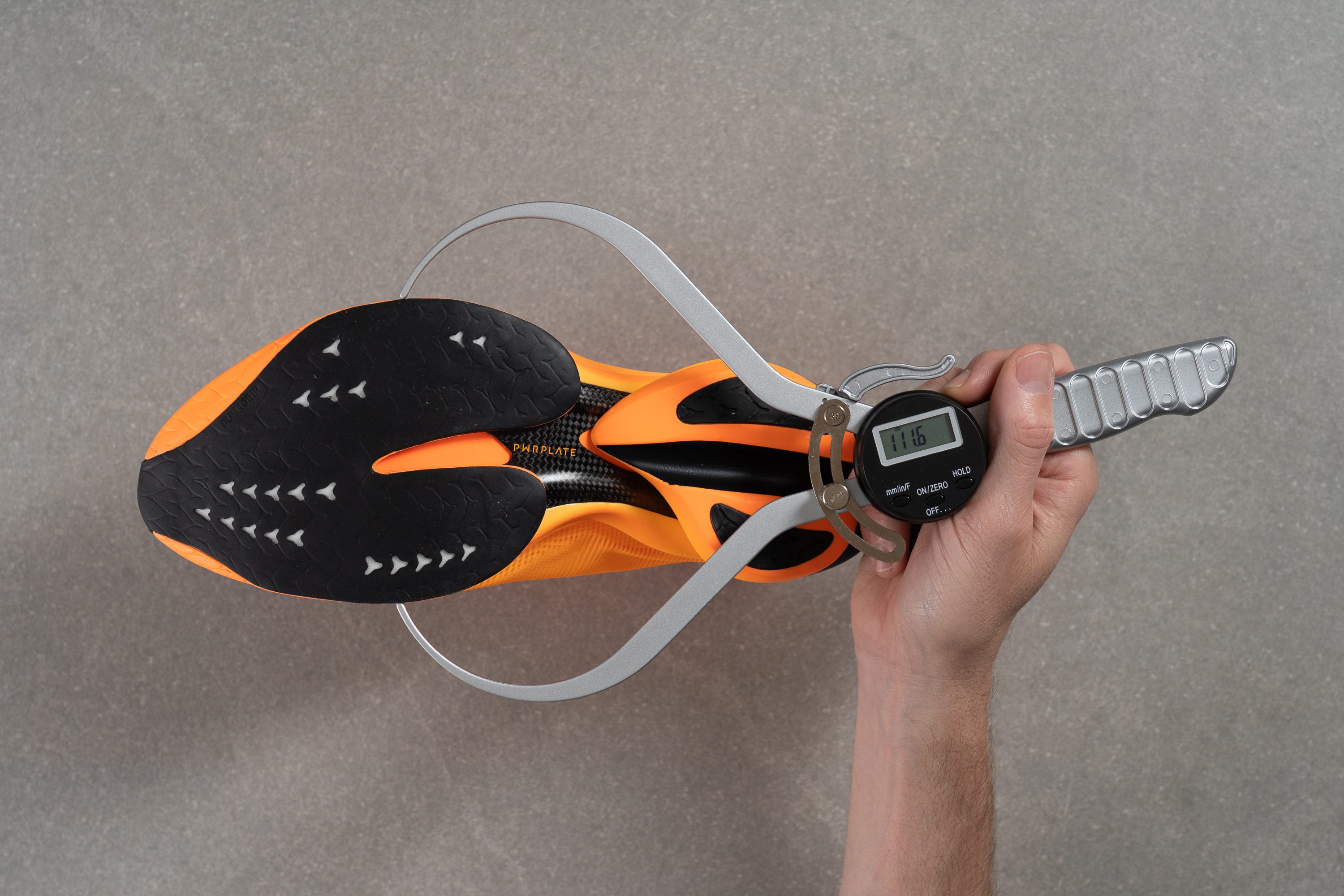
| Fast-R Nitro Elite 3 | 111.6 mm |
| Average | 114.3 mm |
Midsole width - heel
One of the biggest drawbacks of the Fast-R Nitro Elite 3 lies in its heel width. At just 80.0 mm, stability is limited, and we believe it’s unsuitable for runners who need extra support, particularly heavier athletes.
On the bright side, this narrow heel benefits lighter runners or those landing farther forward, making the Fast-R Nitro Elite 3 impressively agile and promoting quicker ground contact times.
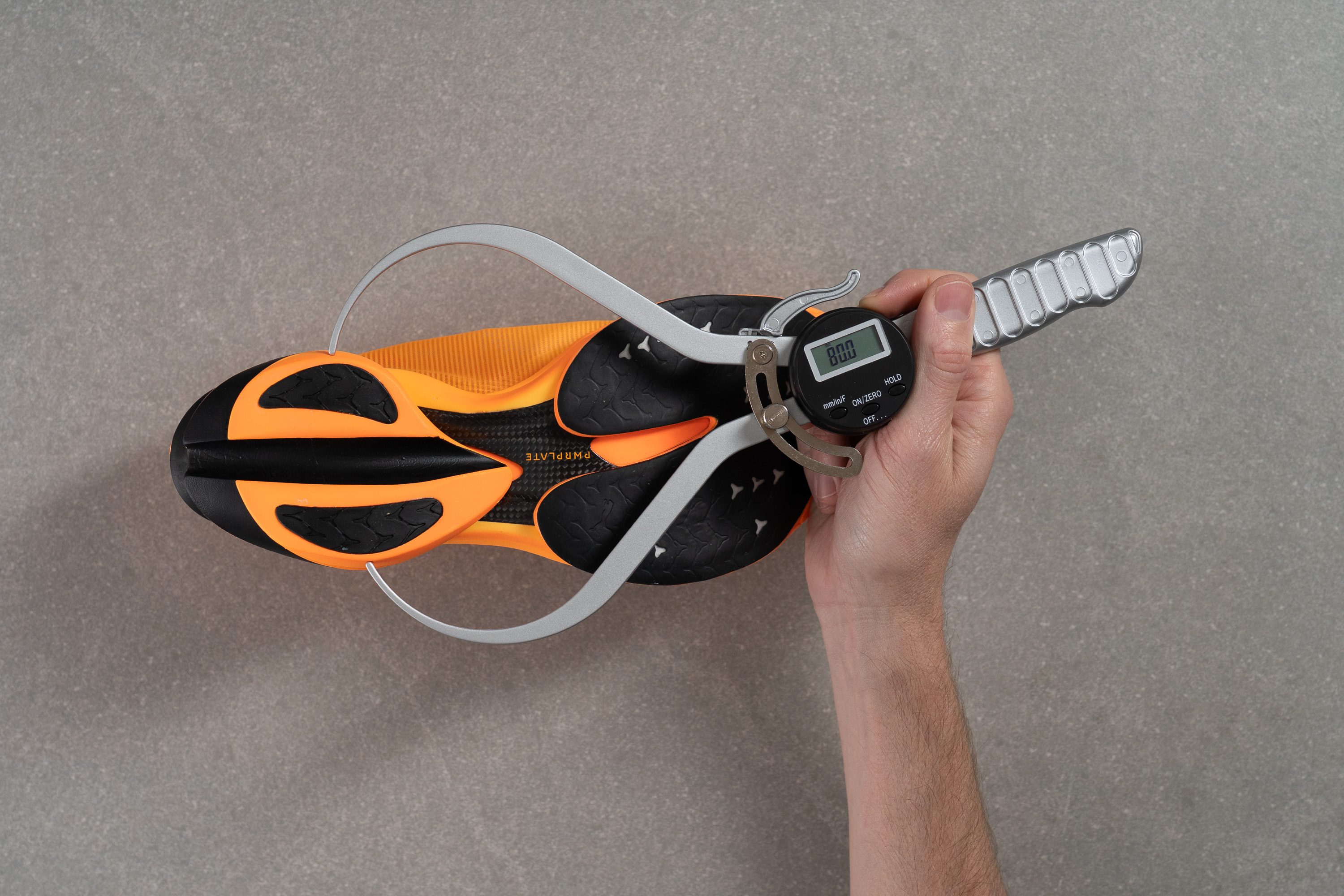
| Fast-R Nitro Elite 3 | 80.0 mm |
| Average | 90.7 mm |
Durability
Toebox durability
The trade-off for a shoe that pushes performance to the absolute limit is durability. The paper-thin upper offers almost no abrasion resistance and unsurprisingly scored a 1/5 in our durability test.
| Fast-R Nitro Elite 3 | 1 |
| Average | 2.6 |
Heel padding durability
While the previous result was somewhat expected, this one came as a disappointing surprise. The heel padding scored only 2/5, raising concerns about early wear.
| Fast-R Nitro Elite 3 | 2 |
| Average | 3.4 |
Outsole durability
The PumaGrip rubber on this shoe resembles a Formula 1 slick tire: built for maximum traction but not longevity. Therefore, grip is phenomenal, yet durability is equally extreme, with 3.1 mm of rubber worn away during our test.
| Fast-R Nitro Elite 3 | 3.1 mm |
| Average | 1.1 mm |
Outsole thickness
To minimize weight, PUMA used only 1.5 mm of rubber on the outsole. Based on our tests, we reaffirm that this shoe is best reserved for race days and the occasional key workout.
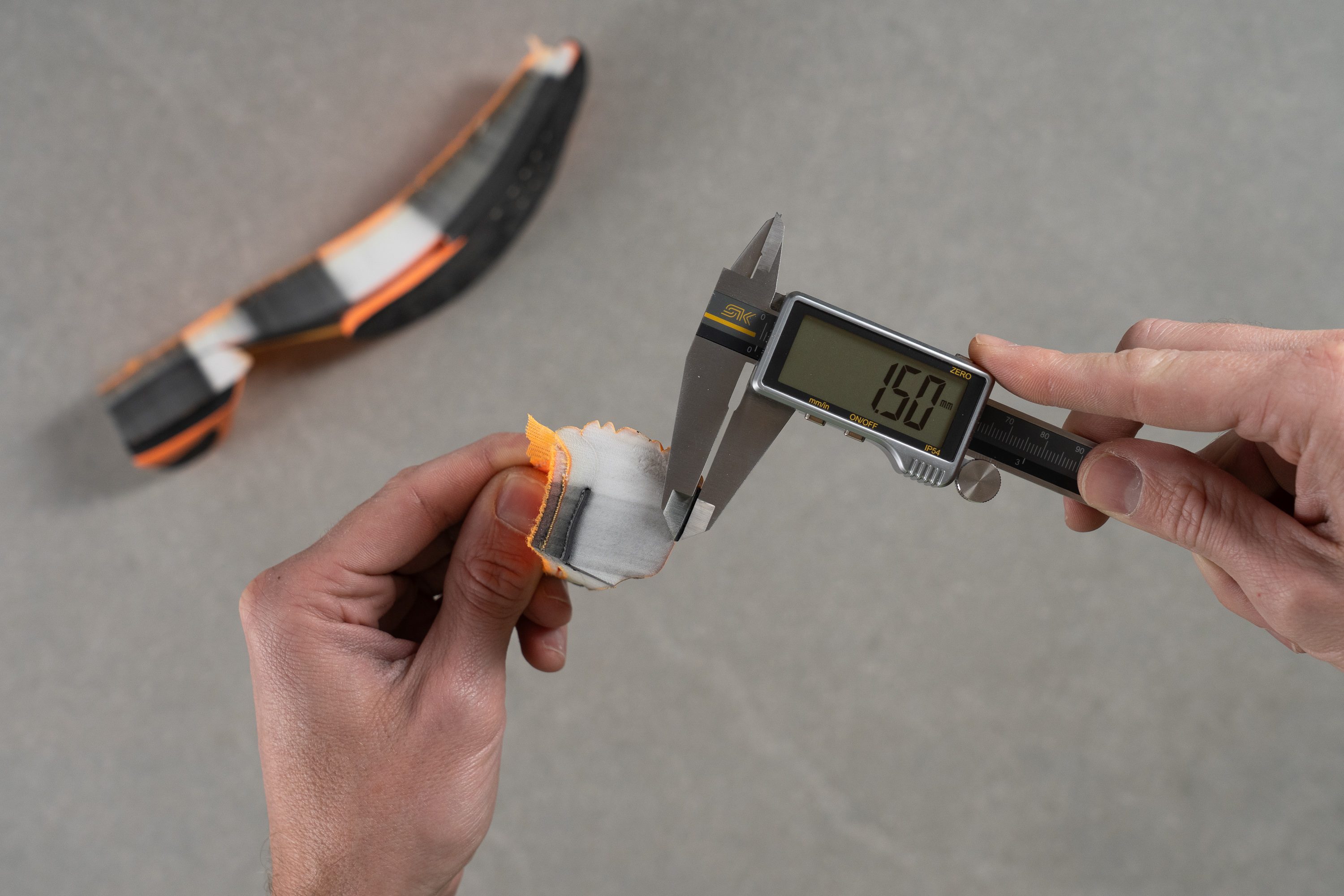
| Fast-R Nitro Elite 3 | 1.5 mm |
| Average | 3.2 mm |
Misc
Insole thickness
We measured the insole and found that it contributes an extra 3.5 mm of cushioning to the overall setup.
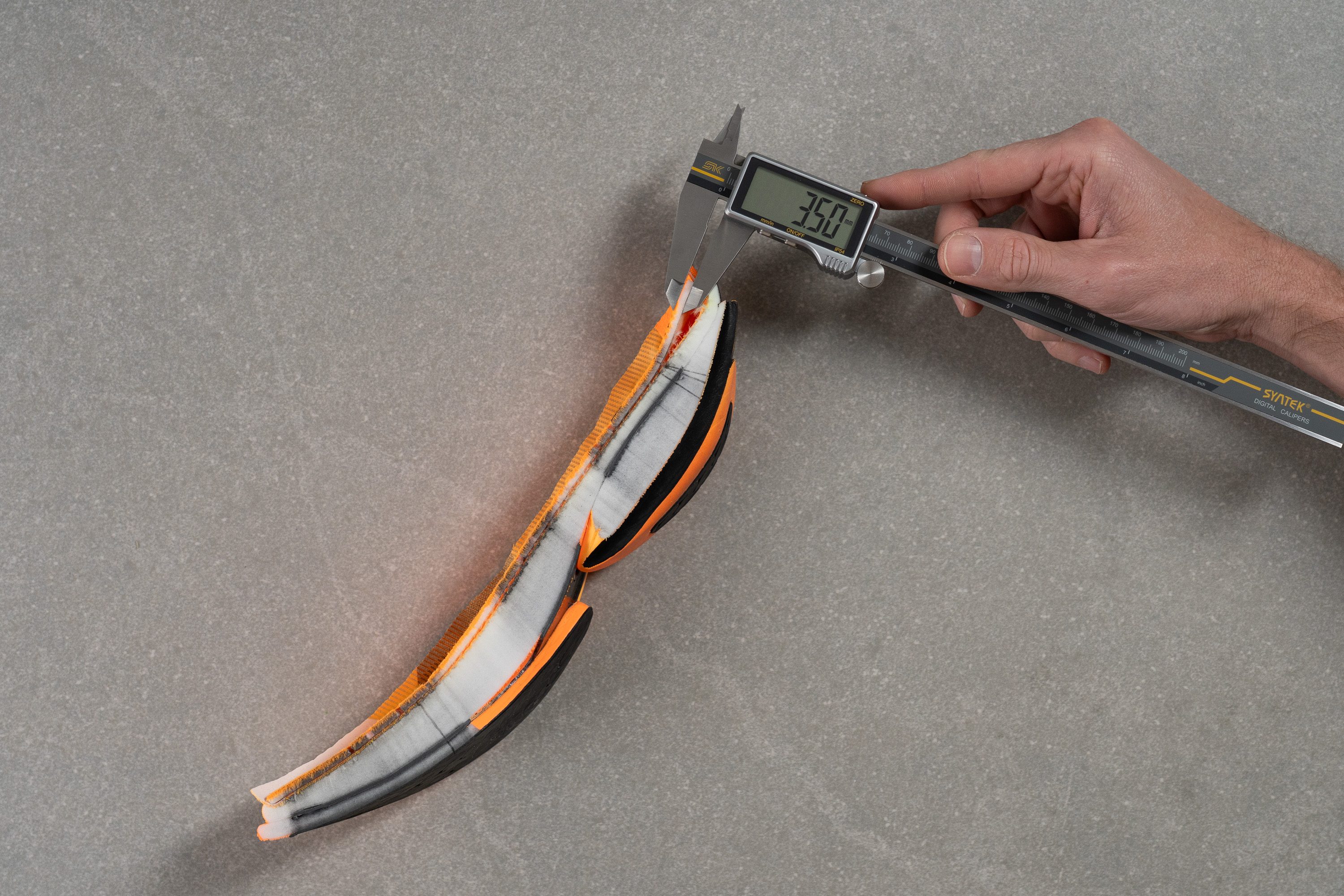
| Fast-R Nitro Elite 3 | 3.5 mm |
| Average | 4.5 mm |
Removable insole
The insole is non-removable, so you’ll need to stick with the one that comes built into the shoe.
| Fast-R Nitro Elite 3 | No |
Midsole softness in cold (%)
One of the greatest advantages of A-TPU foams is their remarkable consistency in cold conditions. While most EVA foams become noticeably firmer and PEBA performs better but still stiffens slightly, PUMA’s Nitro Elite foam only increased firmness by 2% after 20 minutes in our freezer.
That’s genuinely impressive and further proof that A-TPU has truly overtaken PEBA.
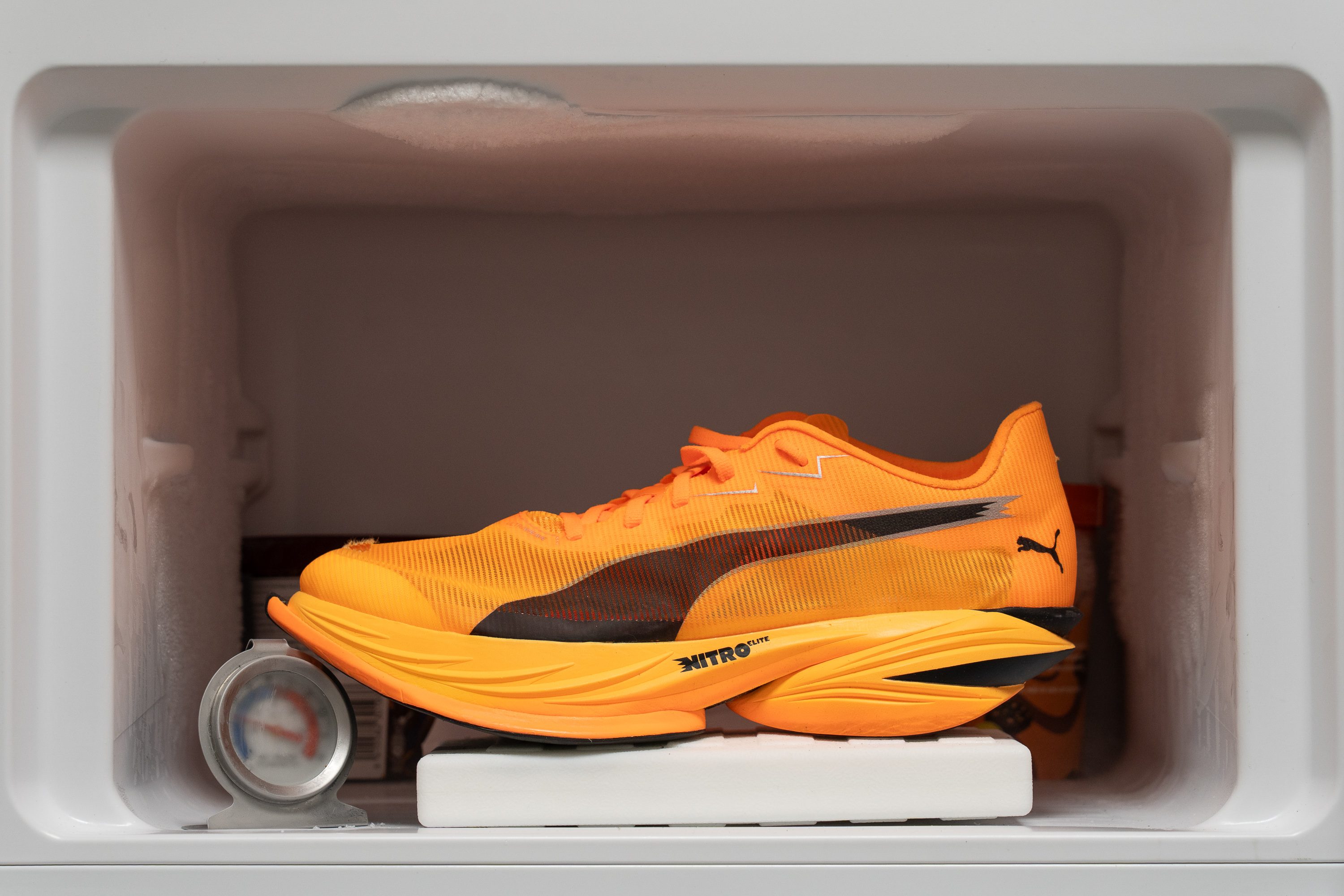
| Fast-R Nitro Elite 3 | 2% |
| Average | 24% |
Reflective elements
The Fast-R Nitro Elite 3 skips reflective details entirely, which comes as no surprise.

| Fast-R Nitro Elite 3 | No |
Tongue padding
The Fast-R Nitro Elite 3 comes with an astonishingly high price tag, but unlike many competitors, PUMA truly delivers both performance and thoughtful extras. One of those perks is the inclusion of two lace options inside the box: a standard elastic pair and a textured, grippy version similar to what most supershoes now use.
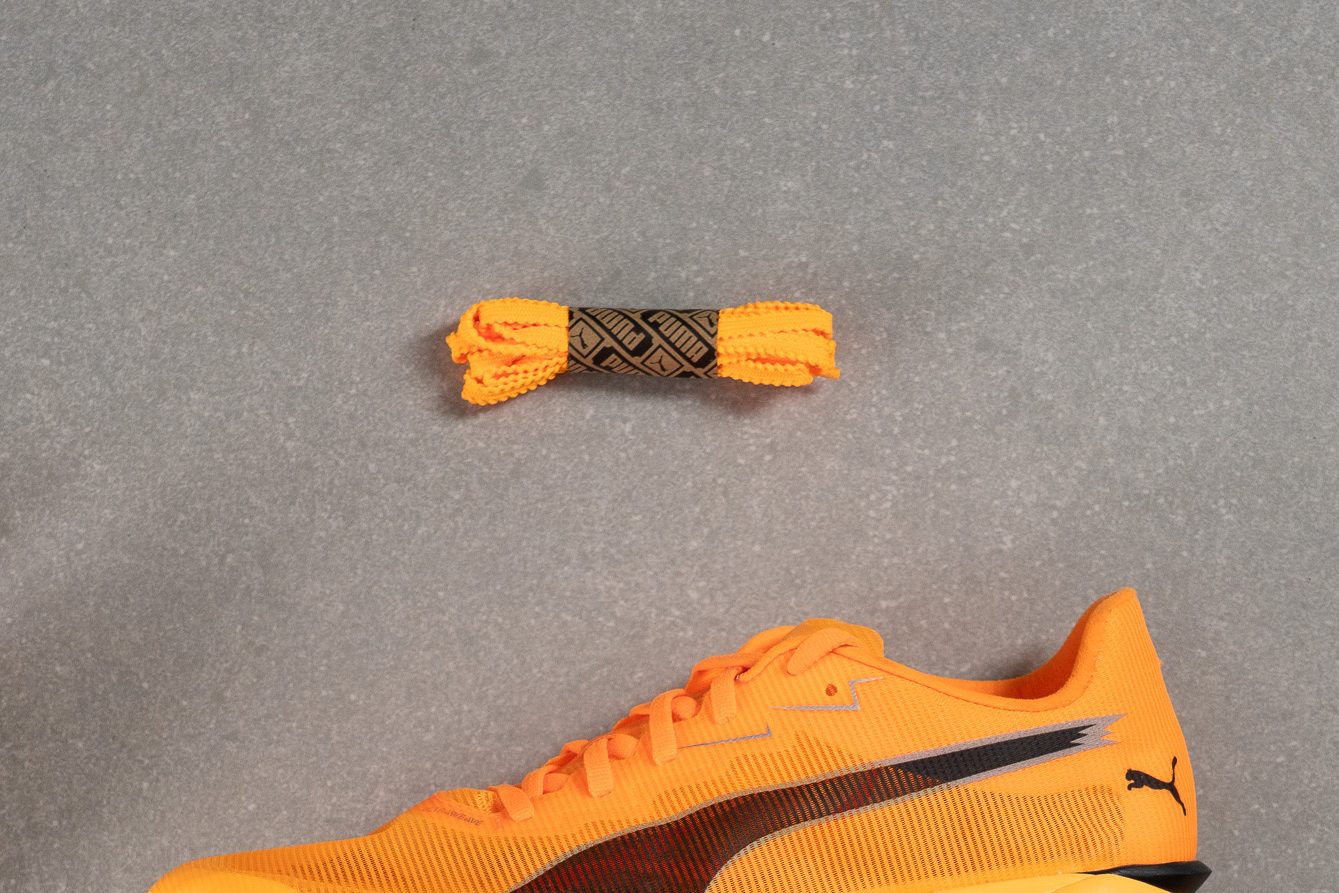
Lockdown is excellent thanks to the simple-yet-reliable punched eyelet design, providing a secure fit with either lace type, though we found the textured ones slightly safer for faster efforts after trying both options.

The tongue is as crazy as the rest of the shoe, featuring an ultra-thin 0.4 mm of padding at the top. That said, PUMA added a small piece of foam just below to relieve pressure, although we believe it could sit a bit higher to better protect the area where the laces are tied.
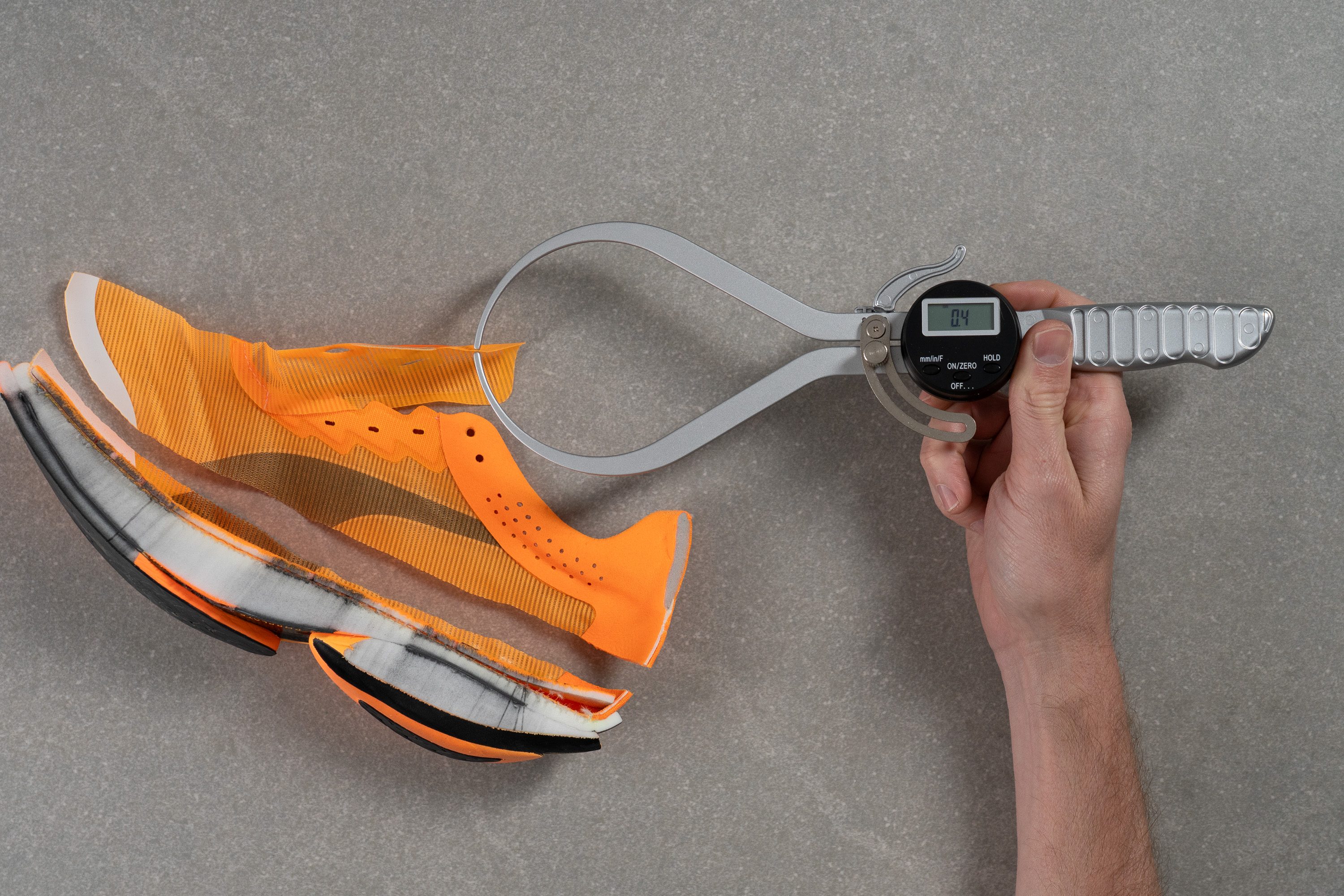
| Fast-R Nitro Elite 3 | 0.4 mm |
| Average | 5.8 mm |
Tongue: gusset type
As it happens with most supershoes, the tongue is not attached to the sides. However, we discovered that its triple lace loop is a clever feature that greatly reduces sliding and keeps everything secure.
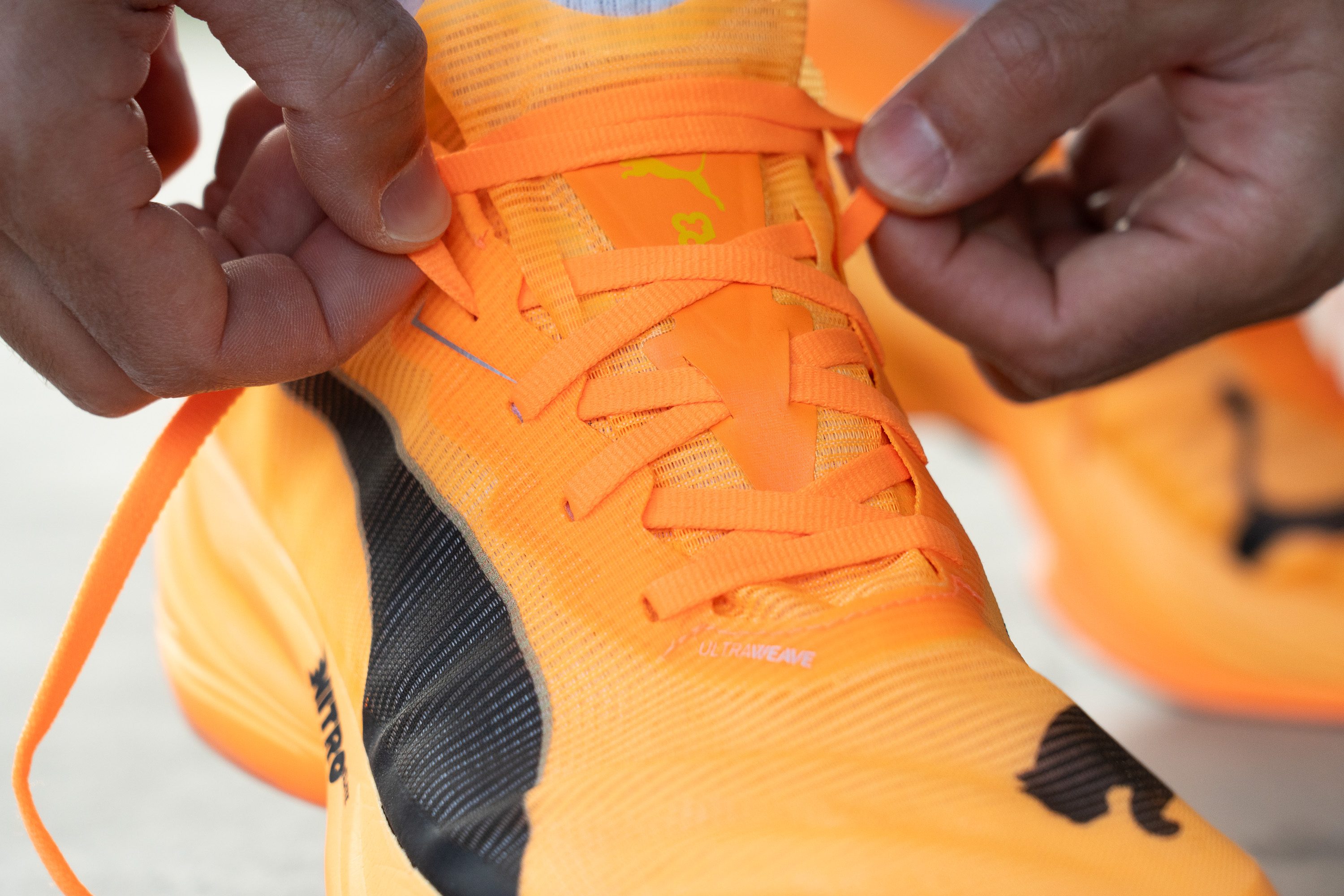
This smart, detail-focused setup works far better than what we’ve seen in competitors that only include a single loop.

| Fast-R Nitro Elite 3 | None |
Price
The price of the Fast-R Nitro Elite 3 sits at the higher end of the supershoe spectrum, but considering its specs and our lab results, we believe it’s absolutely justified. Like ASICS did with the Metaspeed Ray, this shoe pushes the market in the right direction with its impressive combination of ultra-high energy return and low weight.
| Fast-R Nitro Elite 3 | $300 |
| Average | $152 |
Heel tab
The heel design is straightforward and comes without any pull tab, yet a closer look reveals a rigid insert that PUMA strategically placed to enhance lockdown and minimize unwanted movement inside the shoe.

| Fast-R Nitro Elite 3 | None |

